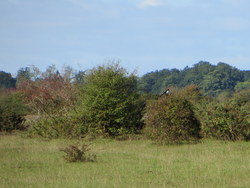This is the southeastern one of four parcels (commonly called "lozenges") bordered by the former runway and taxiways. The lozenges form four similarly sized, long linear sections, all of which are very rich in flora, containing national and Berkshire rarities. Dipping gently from north to south, compartment 10 has distinct bands of vegetation conforming to the topography and contains extensive areas of gorse, heath and acid grassland. The total area is 20.6 ha.
General description and evaluation of ecology

Compartment 10 is fairly dry and supports a complex of dry heath, fragments of lichen heath, acid grassland, neutral grassland and relatively small patches of gorse scrub. The distinction between acid and neutral grassland is not clearly defined but the more acid grassland supports milkwort, oval sedge, heath speedwell and pignut. Some areas are richer in species and contain nationally scarce annual knawel and upright chickweed.
At the eastern end and towards the centre the grassland tends to be more neutral in composition. Green winged orchid, an uncommon species for this county, has been found in two locations. A strong localised calcareous influence can be found in certain locations, indicated by dwarf thistle and great burnet, a species more often associated with damp meadows. This compartment is also important for fungi, lichen, mosses and common dodder especially along the southern margin among the substantial tracts of gorse and heather here. Scrub species are more diverse with scattered dog-rose, bramble and young hawthorn in addition to gorse.
The compartment contains the two transect routes for condition monitoring, walked every few years to record the vegetation and assess the impact of grazing on the heathland and grassland communities.
BAP habitats
- Lowland heathland
- Lowland dry acid grassland
- Lowland meadow
Higher Level Stewardship
Options exist for this compartment.
- HO1 (maintenance of lowland heathland)
- HK6 (maintenance of species-rich, semi-natural grassland)
- HR2 (supplement for native breeds at risk)
Overall management objectives
The main management here will be scrub control, predominantly to reduce any further expansion of gorse into species-rich areas of grassland and heathland, while maintaining a diversely structured mosaic in the stands of heather, gorse and dwarf gorse. This compartment must retain a short sward, and remain the most open and free from gorse and scrub, compared to the 3 other lozenges (compartments 9, 11 and 12).
Compartment 10 (19.4 ha)
| Objective | Area | Method | Comment |
|---|---|---|---|
| 10.1) Maintain and where possible, expand the areas of existing heathland and acid and neutral grassland mosaic into areas dominated by gorse or species-poor grassland. | Across compartment. | Suitable areas of gorse can be cut, the arisings removed and the ground scraped to remove litter. Allow to re-generate naturally.
Species-poor areas can have very small scrapes made within them to create bare gravel areas. Control ragwort. |
Refer to Gorse Management Plan (WBC 2012). |
10.2) Diversify heathland structure.HLS objectives |
Across compartment. | Grazing is the primary tool. Monitoring of the grassland sward and control of grazing is a vital part of this management.
Mow and scrape small sections of the heathland each year to maintain a diverse structure. Cuttings can be used for regeneration elsewhere. Remove all scrub from areas identified as important for fungi and bryophytes. |
Refer to Gorse Management Plan (WBC 2012).
Investigation is ongoing into the invasive liverwort mentioned in the Bryophyte and Lichen Site Dossier (NatureBureau 2009). |